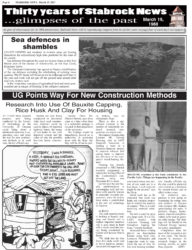COASTLANDERS and residents in riverain areas are bracing themselves for extraordinary high tides predicted for this time of the month.
Sea defences throughout the coast are in poor shape as this Ken Moore shot of the section of Atlanticville, on the East Coast, Demerara shows.
The European Community has agreed to finance rehabilitation of the sea defences including the refurbishing of existing stone quarries. The EC funds will however not be disbursed until later in the year and work will not get off the ground until around after mid-year, sources said.
In the meantime, vast areas of agricultural land and many communities are in danger of flooding if the collapse continues.
UG Points Way For New Construction Methods
 Research Into Use Of Bauxite Capping, Rice Husk And Clay For Housing
Research Into Use Of Bauxite Capping, Rice Husk And Clay For Housing
AT LEAST three research projects now being conducted by the Faculty of Technology at the University of Guyana could bring about a substantial reduction in engineering costs and point the way for new construction methods to be used here, faculty officials say.
Studies are now being conducted to determine what local road construction materials could be used in places of imported highway bases, the usage of rice husks to mix with imported cement and the value of clay for possible low-cost house construction.
Faculty Dean Mr. Charles Garrett, says these come at a time when there is a noticeable upsurge in research in that department of the university.
The findings would be immediately passed on to authorities in particular areas with the hope that they will be of use to policy makers, says an enthusiastic Dean.
There is also a significant increase in the number of industrially initiated research programmes on stream now.
Mechanical Engineering Lecturer Mr. Akwasi Boateng, also an IAST Research Associate, is leading a team on a Demtoco-financed project to improve tobacco leaf curing barns to improve the efficiency of the company’s wood-burning furnace.
Boateng has already completed a GEC-funded research assignment to reduce the fouling effect of the Corporation’s condensers, using raw Demerara River water.
Garrett says the new faculty administration is encouraging staff and students with specific interest to undertake research programmes, since the faculty must make a contribution to the state of technology in Guyana.
SURVEY
The road materials study is looking at bauxite capping and laterite soil to replace imported materials and it goes hand in hand with a roads condition survey being researched by Garrett and lecturer Marva Burke.
“We think that the data from this study could lead to better highway maintenance and management. As you would notice now, several of our roads are in a bad shape. Local materials might be the answer,” says the Dean.
Initial work has so far indicated that local rice husks ash contains properties to extend the quantity of cement. “This is a study receiving renewed attention.
We feel it could be done on a large scale. It is a UG-LAST project with Lecturers Boateng and Gonsalves leading the team,” Garrett disclosed.
Increased focus is being placed on Amerindian houses using local clay. Lecturers Hernandez and Langevine want to maximise the use of clay for low cost housing construction. Faculty officials say the clay could be plastered with cement as a substitute for cement blocks and in effect reduce costs.
An extensive programme is now going on examining the energy uses and systems in Guyana with Lecturer Mel Sankies spearheading the team. It includes biogas, hydro-power, charcoal and photovoltaic cells used to generate solar energy. The findings will be handed to the National Energy Agency for policy amendment.
Completion time for most of the research is put at two years. The faculty expects to increase its research budget in the coming months to assist these projects. —(DW)





